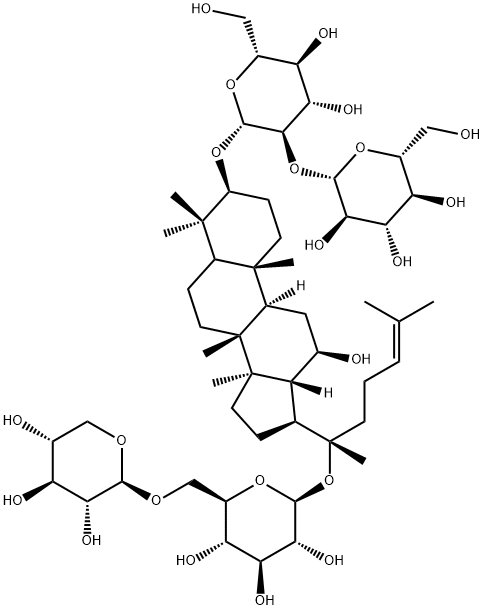68406-26-8
 68406-26-8 結(jié)構(gòu)式
68406-26-8 結(jié)構(gòu)式
基本信息
紅茶浸膏粉
西洋參多糖
絞股藍(lán)皂V
人參皂莢RB2
人參皂甙 RB3
人參皂苷RB3對(duì)照品,
人參皂苷RB3(標(biāo)準(zhǔn)品)
人參皂苷 RB3, 來源于人參
人參皂苷RB3(人參皂莢RB2
Gypenoside IV
xylopyranosyl-
GINSENOSIDE RB3
GINSENOSIDE Rb3(SH)
Ginsenoside Rb3 ,98%
Ginsenoside Rb3 Gypenoside IV
Ginsenoside Rb3 (CAS#68403-26-8)
hydroxydammar-24-en-20-yl6-O-β-D-
β-D-Glucopyranoside, (3β,12β)-3-[(2-O-β-D-
物理化學(xué)性質(zhì)
| 報(bào)價(jià)日期 | 產(chǎn)品編號(hào) | 產(chǎn)品名稱 | CAS號(hào) | 包裝 | 價(jià)格 |
| 2025/02/08 | HY-N0041 | 人參皂甙 Rb3 Ginsenoside Rb3 | 68406-26-8 | 5mg | 400元 |
| 2025/02/08 | HY-N0041 | 人參皂甙 Rb3 Ginsenoside Rb3 | 68406-26-8 | 10mg | 700元 |
| 2025/02/08 | HY-N0041 | 人參皂甙 Rb3 Ginsenoside Rb3 | 68406-26-8 | 10mM * 1mLin DMSO | 831元 |
常見問題列表
| Target | Value |
|
COX-2
() | |
|
iNOS
() | |
|
NF-κB
(human kidney 293T cell-based assay) | 8.2 μM |
Ginsenoside Rb3 (0.1-10 μM) is tested for inhibition of tumor necrosis factor-α (TNF)-induced nuclear factor kappa-light-chain-enhancer of activated B cells (NF-κB) luciferase reporter activity using a human kidney 293T cell-based assay. Ginsenoside Rb3 shows the significant activity with an IC 50 of 8.2 μM. Ginsenoside Rb3 also inhibits the induction of cyclooxygenase-2 (COX-2) and inducible nitric oxide synthase (iNOS) messenger Ribonucleic acid (mRNA) in a dose-dependent manner after HepG2 cells have been treated with TNF-α (10 ng/mL). Ginsenoside Rb3 (0.1-10 μM) significantly increases cell viability and inhibits lactate dehydrogenase (LDH) release in a dose-dependent manner. PC12 cell viability as determined by MTT reduction is also markedly decreased after the cell is exposed to oxygen and glucose deprivation (OGD)/OGD-Rep. But, when the cells are pretreated with Ginsenoside Rb3 (0.1, 1, and 10 μM), OGD/OGD-Rep induced cell toxicity is significantly attenuated, which is concentration-dependently attenuated by Ginsenoside Rb3 treatment. The viabilities are raised to 52.8%±5.6%, 64.6%±5.7%, and 76.4%±8.8%, respectively, compared with the control group.
Ginsenosides Rb3 is a major compound isolated from Gynostemma pentaphyllum that holistically improves gut microenvironment and induces anti-polyposis in Apc Min/+ mice. Six-weeks-old mice are subjected to Rb3 treatment, before the appearance of the intestinal polyps. All the mice are monitored for food intake, water consumption, and weight changes. Throughout the experiment, no Rb3/Rd-associated weight loss in mice is observed. In addition, none of the treated mice show variations in food and water consumption. Whereas, the number and size of the polyps are effectively reduced by Rb3 treatments.
